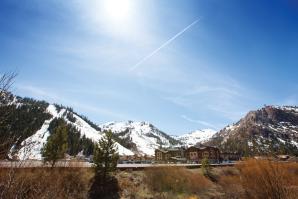In the 35 years Ken Ruzich has managed local levees, no water event has been more memorable than the 1986 flood that nearly toppled levees along the Yolo bypass. If it wasn’t a 100-year flood, he says, it was close enough: “It was our benchmark.”
The Yolo bypass holds about 80 percent of the Sacramento River’s floodwaters during large events, routing water from bordering cities. During the March 1986 flood, the bypass conveyed roughly 12.5 billion cubic meters of water, more than three times the total flood-control storage volume in all Sacramento basin reservoirs.
“The Yolo bypass is real susceptible to wave action. The static water was 3 or 4 feet below the levee, but the waves were hitting the top of the levee, and when the waves started kicking up they started eroding the levee,” says Ruzich, the general manager for Water Reclamation District 900. “We lost probably a third of the crown of that levee in about 12 hours. We were hauling rock and sandbagging. Fortunately the weather improved, and we survived.”
A decade later deficiencies requiring repair were discovered along that same swath of bypass straddling Interstate 80 west of the I-80/Highway 50 merge. In addition, the West Sacramento Area Flood Control Agency and the Army Corps of Engineers identified additional inadequacies in the Sacramento bypass levee near the Bryte Bend Bridge on Interstate 80 and in the Sacramento north river levee near Bryte Park and at the I Street Bridge. Farther to the south, six miles of levee bordering the Sacramento River are also being analyzed for deficiencies and repairs.
“The levees are as good as they’ve ever been because we’ve improved them, but the criteria are getting more and more strict,” says Michael Bessette, West Sacramento’s flood protection manager. Much of the current work is proactive, he says, and the timing of upcoming improvement projects is meant to capitalize on federal funding and incentives.
West Sacramento is moving forward now with “early implementation projects” — those that break ground ahead of the state’s schedule for its Central Valley Flood Management Planning Program — in an effort to snatch federal assistance for as many projects as possible before time and money run out.
“It’s sort of a leap of faith that we’re going to get authorized,” Bessette says.
The Central Valley Flood Management Planning Program was established in 2007 to improve integrated flood management in the Sacramento and San Joaquin valleys. Authorized projects within the program are funded at 65 percent by the federal government. The state would chip in another 25 percent, leaving just 10 percent of West Sacramento’s $460 million levee improvement price tag on the shoulders of its taxpayers.
The first project, a slip repair on the Yolo bypass, was completed in 2009 and cost about $2.5 million to construct. A second slip nearby will be repaired this year for about $4 million to $5 million. Fully funding the projects and working ahead of approval, West Sacramento officials can only hope the city will be reimbursed for the portion of those jobs that should be shouldered by the state and federal governments.
In the wake of hurricanes Katrina and Rita, the state of California took a look at its massive levee system and through a series of problem identification studies discovered needed repairs over the next decade.
West Sacramento’s levees do not meet the new state-mandated 200-year-flood standards implemented in 2007, but they are not at immediate risk of failing. The city has a handful of spots at risk for erosion because of water seeping underneath the levees. In addition, geometric standards for levees have changed since the Sacramento River levee was built in the early 1900s.
“The levees are as good as they’ve ever been because we’ve improved them, but the criteria are getting more and more strict.”
Michael Bessette, flood protection manager, city of West Sacramento
For reliability, strength and environmental health, West Sacramento could opt for setback levees, as opposed to the adjacent levees of Natomas. An adjacent levee physically builds upon an existing levee by widening the levee’s footprint. But setback levees allow for greater habitat restoration, according to Ric Reinhardt of MBK Engineers, who is working on the project. They are physically separate levees that would be built about 400 feet behind the existing levee.
“There are a number of engineering considerations that make setback levees attractive, and if we can bring the funding agencies together, it could make a lot of sense. But it is a higher cost, and it affects the city’s infrastructure,” Reinhardt says.
In an effort to improve the health of the river, engineers are considering cutting down the height of the old levees, allowing the river to meander and expand during high-water events. It would be a benefit to the salmon, in particular, because they are negatively impacted by the river’s physical constraints. The river could expand by 400 feet before reaching setback levees, which would be built to protect against a 200-year flood.
“Levees work best if they are not right on the banks of the river. The river is always doing its thing: eroding and depositing,” says Ron Stork, senior policy advocate for Friends of the River. “Having some flood plain land between the river bank and the levee is the safest kind of levee to build because the river isn’t working to undercut the levee. The flood flows slow down, so the river itself is not putting its highest energy against the levee’s foundation.”
But in order to move forward with setback levee planning, West Sacramento will have to give up some potentially developable land, “and if you lose development, you lose resources,” Bessette says.
Estimating the value of the land and the forgone fees from development is part of West Sacramento’s scoping process, which will occur over the next four to five months.
“We have to see if it makes sense and if there are funding sources out there that would pay for that loss of income,” Bessette says.
While environmental advocates commend West Sacramento for its choice of levee design options, they are not pleased with a new Army Corps policy calling for the removal of all vegetation from current and future levees. The Department of Water Resources has released public comment opposing the policy, but there is no definitive word yet on whether West Sacramento will comply.
According to the Army Corps, the policy was implemented as a public safety measure because “vegetation and other encroachments can harm the structural integrity of infrastructure, obscure visibility for visual inspections, impede access for maintenance and inspection and/or hinder emergency flood fighting operations.”
Friends of the River, the California Department of Water Resources and members of Congress, including John Garamendi and Doris Matsui, have advocated against the policy.
One letter written to Jo-Ellen Darcy, assistant secretary of the Army Corps, and signed by 17 members of Congress, said: “The new guidance has the potential to impact thousands of miles of levees across California, compromise our already fragile ecosystems, place a large financial burden on our struggling economy, ignore region-specific conditions and negatively impact public safety.”
Reinhardt, a former corps engineer, isn’t too concerned about where the chips will fall on the matter because, he says, the corps is reasonable and could allow for compliance alternatives. In addition, he agrees that vegetation can affect the integrity of levees and says advancing the conversation about habitat and flood management can bring positive results.
“There is no doubt that they understand that flood management is so much more than these projects.” —Ric Reinhardt, principal, MBK Engineers
“I look at the policy as an opportunity to try to innovate from what has been the status quo in engineering practices. There are benefits to such a policy,” he says.
“The policy has been widely debated, but one of the positive things that has come out of it are projects that are better for the environment than those done over the past 30 years.”
Throughout 2011 scientific documentation will be provided by the corps in an effort to further explain and defend its vegetation policy. During that time, engineers will also continue to evaluate levee design options and best practices, and West Sacramento will provide data about project costs and funding sources.
Some of those cost projections could be huge if the city discovers it needs to purchase private properties to move forward with construction. Bygone state easement policies called for just a 15-foot encroachment buffer between development and the levees, so there are a number of properties that could land in the path of a setback or, in some cases, an adjacent levee.
“We are scoping out the entire six miles and looking at alternative ways to improve the levee system given the constraints out there,” Bessette says. “There may be situations where we might have to purchase a home in order to do the best levee improvement for the lowest cost. … We’re trying to accomplish a lot of goals in one project.”
Updated development codes in West Sacramento now require approval for anything built within 300 feet of a levee.
“You can farm it or landscape it, but you cannot build a structure that would inhibit flood fighting,” Bessette says.
Still, West Sacramento voters have shown support for healthy levees, and so far they have been more than willing to pay for it. In 2007, the city’s voters approved a $40 million property tax assessment, which equates to about $150 per single-occupancy house, on average, for levee improvements the decade to follow.
Then, in 2008, voters approved an extension of Measure K, a 2.5-cent sales tax that was previously applied to road construction and maintenance and is now applied to flood protection.
The city also has an in-lieu fee on new development. The one-time fee required of developers should equate to about $40 million for flood protection when the city reaches full buildout.
“We don’t know of any other community in California that has all three of these funding mechanisms,” Bessette says. “Our citizens are very aggressive.”
And city managers are aggressive too. Bessette says he and his colleagues are focused on protecting life and property and will always be focused on improving levees and managing flood risk.
Reinhardt says: “There is no doubt that they understand that flood management is so much more than these projects. They educate their public continually, they have developed emergency evacuation response plans, and they have also looked across the spectrum about how they can raise sustainable revenue streams. It’s a very balanced approach.”
Recommended For You

Levee Over Troubled Waters
Paying for repairs just got harder
It’s a calm, clear day on West Sacramento’s South River Road, a meandering two-lane route that runs atop a levee buffering houses and farmland from the placid Sacramento River. It’s hard to envision the chaos that would ensue if the great dirt barrier were to burst, pouring millions of gallons of water into adjacent homes and businesses, but that nightmare scenario just got harder to prevent.

Water Under the Bridge
A plan for Squaw Creek is a plan for jobs
Squaw Valley USA was once the premier ski resort of California and the world-renowned site of the 1960 Winter Olympic Games. But in the decades that followed, the resort’s managers focused on the mountain, and Squaw became eclipsed by other resorts that boasted hotel rooms and other amenities to capture business in the dry months.



